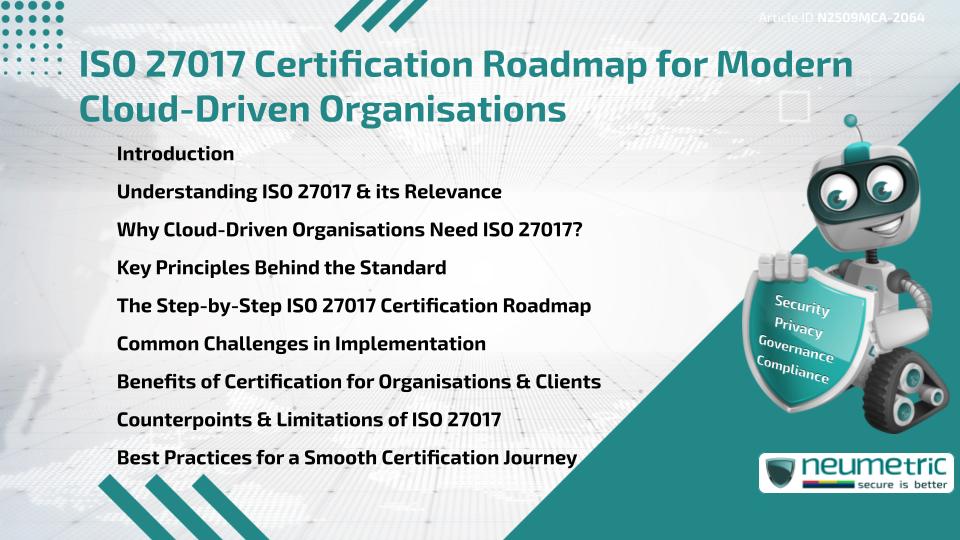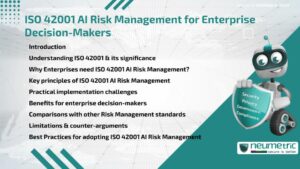Table of Contents
ToggleIntroduction
ISO 27017 compliance Monitoring Tools play a vital role in ensuring that Organisations maintain Secure & Compliant Cloud Environments. These tools help businesses continuously assess Risks, automate compliance checks & detect Vulnerabilities in line with the international Framework. By implementing effective monitoring, companies can safeguard Sensitive Data, meet regulatory requirements & build trust with customers. Cloud adoption has grown rapidly, making Continuous Monitoring essential to identify potential gaps before they become serious Threats. This article explores the role, features, challenges & practical applications of ISO 27017 compliance Monitoring Tools for continuous Cloud Security.
Understanding ISO 27017 & its Relevance
The International Organisation for Standardization [ISO] developed ISO 27017 as a security Standard specifically tailored for cloud service providers & customers. It provides guidelines for implementing Information Security Controls in cloud environments. Unlike ISO 27001, which addresses overall Information Security management, ISO 27017 focuses on Risks unique to cloud operations such as data segregation, multi-tenancy & shared responsibility.
ISO 27017 compliance Monitoring Tools help enforce these controls in real time. They provide dashboards, alerts & Audit-ready reports that demonstrate adherence to the Framework. This ensures that both cloud providers & customers remain aligned on their security obligations.
Why Compliance Monitoring Tools are Essential for Cloud Security?
Cloud Security is not static; Threats evolve constantly. Traditional audits performed once or twice a year are insufficient to guarantee continuous protection. ISO 27017 compliance Monitoring Tools bridge this gap by automating checks & identifying Risks around the clock.
For example, these tools can track Access Controls, data movement & misconfigured cloud services. They also reduce the manual workload for security teams, freeing resources to focus on strategic Risk Management. Moreover, they help Organisations prove compliance during regulatory inspections without scrambling to gather Evidence at the last moment.
Core Features of ISO 27017 Compliance Monitoring Tools
The effectiveness of these tools lies in their ability to integrate compliance frameworks with technical monitoring. Some common features include:
- Automated assessments that map cloud configurations against ISO 27017 controls
- Real-time alerts when deviations or anomalies are detected
- Audit-ready reporting that satisfies regulators & customers alike
- Integration with security information & event management [SIEM] systems for centralized visibility
- Role-based dashboards that offer tailored insights for executives, administrators & compliance officers
These features ensure that security teams can move beyond reactive responses & embrace proactive cloud defense.
Limitations & Challenges of Compliance Monitoring
While valuable, ISO 27017 compliance Monitoring Tools are not without limitations. They can generate false positives that overwhelm teams if not tuned correctly. Implementing these tools may also require significant investment in time & resources. Furthermore, compliance does not always equal security-tools may confirm adherence to standards but fail to detect sophisticated, targeted attacks.
Organisations should view these tools as part of a layered approach rather than a complete solution. Combining monitoring with Employee Training, Incident Response planning & periodic audits ensures stronger resilience.
Practical Use Cases Across Industries
ISO 27017 compliance Monitoring Tools are relevant across diverse industries that rely on cloud infrastructure. Financial institutions use them to secure transaction data, while Healthcare providers apply them to protect Patient Records under strict Privacy regulations. Retailers benefit by monitoring Customer Data & payment systems, reducing the Risk of breaches.
These use cases highlight how Monitoring Tools not only prevent incidents but also help Organisations demonstrate accountability to Stakeholders.
How to Select the Right ISO 27017 Compliance Monitoring Tools?
Selecting the right tool involves considering both technical capabilities & organizational needs. Businesses should ask:
- Does the tool integrate seamlessly with existing cloud platforms?
- Can it scale as the organisation grows?
- Does it offer user-friendly reporting for both technical & non-technical Stakeholders?
- Is vendor support reliable & timely?
By aligning these factors with Compliance Requirements, Organisations can ensure they invest in solutions that deliver long-term value.
Common Misconceptions about ISO 27017 Compliance
One common misconception is that adopting ISO 27017 guarantees total security. In reality, it provides a Framework but requires ongoing effort to implement effectively. Another misconception is that Monitoring Tools are only necessary for large enterprises. Small & medium-sized businesses also benefit significantly from automation, especially when resources are limited.
Understanding these misconceptions helps Organisations set realistic expectations & avoid over-reliance on tools alone.
Best Practices for Continuous Cloud Security
To maximize the benefits of ISO 27017 compliance Monitoring Tools, Organisations should adopt Best Practices such as:
- Regularly updating monitoring rules to reflect evolving Threats
- Conducting simulated Incident Response drills
- Reviewing vendor compliance to ensure shared responsibility is upheld
- Combining automated monitoring with periodic manual audits
These practices create a culture of Continuous Improvement & enhance trust in cloud operations.
Takeaways
ISO 27017 compliance Monitoring Tools are indispensable for maintaining secure cloud environments. They provide real-time visibility, automate compliance checks & support regulatory adherence. However, they should be complemented by training, layered defenses & proactive Risk Management. Organisations that strategically adopt these tools can reduce Risks, increase trust & demonstrate accountability.
FAQ
What is ISO 27017 in simple terms?
ISO 27017 is a security Standard that provides guidelines for protecting information in cloud environments.
How do ISO 27017 compliance Monitoring Tools improve Cloud Security?
They continuously check cloud configurations, detect Vulnerabilities & generate reports to ensure compliance with ISO 27017 controls.
Are these tools necessary for Small Businesses?
Yes, Small Businesses benefit from automation, reduced manual workload & easier Regulatory Compliance.
Do these tools guarantee complete security?
No, they support compliance but should be part of a broader security strategy that includes training & layered defenses.
What industries use ISO 27017 compliance Monitoring Tools?
Industries such as Finance, Healthcare & retail use them to safeguard Sensitive Data in the cloud.
How often should Organisations review their monitoring setup?
Organisations should review their setup regularly, especially after adopting new cloud services or when Threats evolve.
What is the difference between ISO 27017 & ISO 27001?
ISO 27001 covers general Information Security management, while ISO 27017 focuses specifically on cloud-related Risks.
Need help for Security, Privacy, Governance & VAPT?
Neumetric provides organisations the necessary help to achieve their Cybersecurity, Compliance, Governance, Privacy, Certifications & Pentesting needs.
Organisations & Businesses, specifically those which provide SaaS & AI Solutions in the Fintech, BFSI & other regulated sectors, usually need a Cybersecurity Partner for meeting & maintaining the ongoing Security & Privacy needs & requirements of their Enterprise Clients & Privacy conscious Customers.
SOC 2, ISO 27001, ISO 42001, NIST, HIPAA, HECVAT, EU GDPR are some of the Frameworks that are served by Fusion – a SaaS, multimodular, multitenant, centralised, automated, Cybersecurity & Compliance Management system.
Neumetric also provides Expert Services for technical security which covers VAPT for Web Applications, APIs, iOS & Android Mobile Apps, Security Testing for AWS & other Cloud Environments & Cloud Infrastructure & other similar scopes.
Reach out to us by Email or filling out the Contact Form…





